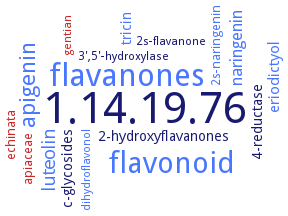1.14.19.76: flavone synthase II
This is an abbreviated version!
For detailed information about flavone synthase II, go to the full flat file.

Word Map on EC 1.14.19.76 
-
1.14.19.76
-
flavanones
-
flavonoid
-
apigenin
-
luteolin
-
naringenin
-
eriodictyol
-
2-hydroxyflavanones
-
c-glycosides
-
tricin
-
4-reductase
-
2s-naringenin
-
echinata
-
apiaceae
-
dihydroflavonol
-
3',5'-hydroxylase
-
2s-flavanone
-
gentian
- 1.14.19.76
- flavanones
- flavonoid
- apigenin
- luteolin
- naringenin
- eriodictyol
-
2-hydroxyflavanones
-
c-glycosides
- tricin
-
4-reductase
- 2s-naringenin
- echinata
- apiaceae
- dihydroflavonol
-
3',5'-hydroxylase
-
2s-flavanone
- gentian
Reaction
Synonyms
AFNS2, CYP93B16, CYP93B2, CYP93G1, CYP93G2, cytochrome P450 93G1, DvFNS, flavone synthase II, FNS II, FNSII, OsFNSII, sb02g000220, SbFNSII, TFNS5
ECTree
Advanced search results
General Information
General Information on EC 1.14.19.76 - flavone synthase II
Please wait a moment until all data is loaded. This message will disappear when all data is loaded.
evolution
D3U591
phylogenetic analyses of the subfamily of plant CYP93B enzymes indicate the evolution of a gene encoding a flavone synthase which originally catalyzes the direct conversion of flavanones into flavones, via early gene duplication into a less efficient enzyme with an altered catalytic mechanism. Ultimately, this allows the evolution of the legume-specific isoflavonoid synthase activity
malfunction
the lignin of the fnsII mutant is completely devoid of tricin, indicating that FNSII activity is essential for the deposition of tricin-bound lignin in rice cell walls. The mutant also shows substantially reduced lignin content with decreased syringyl/guaiacyl lignin unit composition. The loss of tricin in the mutant lignin appears to be partially compensated by incorporating naringenin, which is a preferred substrate of OsFNSII. The fnsII mutant is further revealed to have enhanced enzymatic saccharification efficiency, suggesting that the cell wall recalcitrance of grass biomass may be reduced through the manipulation of the flavonoid monomer supply for lignification
metabolism
physiological function
the dark or light brown color variation in injured leaves of sorghums is associated with the gene expression of flavone synthase II and flavonoid 3'-hydroxylase. Flavone synthase II pathway is activated to synthesize flavones (apigenin and luteolin) and the expression level of flavonoid 3'-hydroxylase changes the balance of apigenin and luteolin. Expression of flavone synthase II is related to the synthesis of flavones (apigenin and luteolin) and the expression level of flavonoid 3'-hydroxylase is related to the balance of apigenin and luteolin. Expression of flavone synthase II and flavonoid 3'-hydroxylase is thus associated with dark or light brown coloration in tan-colored injured leaves of sorghum. Expression of both flavone synthase II and flavonoid 3'-hydroxylase leads to the synthesis of apigenin and luteolin in Sorghum bicolor #7
metabolism
expression of FNSII is related to the synthesis of flavones (apigenin and luteolin). The enzyme is associated with colors in tan-colored injured leaves in sorghum
metabolism
the enzyme channels flavanones to the biosynthesis of tricin O-linked conjugates
metabolism
-
the enzyme is involved in the biosynthesis of flavones from flavanones
metabolism
the enzyme is involved in the flavonoid pathway and is responsible for flavone formation
metabolism
the enzyme plays an essential role in tricin lignification in the cell wall
metabolism
the suppression of flavone synthesis is caused by post-transcriptional gene silencing (PTGS) of FNS II (DvFNS), leading to the high accumulation of both total anthocyanins and cyanidin-based anthocyanins
metabolism
-
the dark or light brown color variation in injured leaves of sorghums is associated with the gene expression of flavone synthase II and flavonoid 3'-hydroxylase. Flavone synthase II pathway is activated to synthesize flavones (apigenin and luteolin) and the expression level of flavonoid 3'-hydroxylase changes the balance of apigenin and luteolin. Expression of flavone synthase II is related to the synthesis of flavones (apigenin and luteolin) and the expression level of flavonoid 3'-hydroxylase is related to the balance of apigenin and luteolin. Expression of flavone synthase II and flavonoid 3'-hydroxylase is thus associated with dark or light brown coloration in tan-colored injured leaves of sorghum. Expression of both flavone synthase II and flavonoid 3'-hydroxylase leads to the synthesis of apigenin and luteolin in Sorghum bicolor #7
-
metabolism
-
expression of FNSII is related to the synthesis of flavones (apigenin and luteolin). The enzyme is associated with colors in tan-colored injured leaves in sorghum
-
metabolism
-
the dark or light brown color variation in injured leaves of sorghums is associated with the gene expression of flavone synthase II and flavonoid 3'-hydroxylase. Flavone synthase II pathway is activated to synthesize flavones (apigenin and luteolin) and the expression level of flavonoid 3'-hydroxylase changes the balance of apigenin and luteolin. Expression of flavone synthase II is related to the synthesis of flavones (apigenin and luteolin) and the expression level of flavonoid 3'-hydroxylase is related to the balance of apigenin and luteolin. Expression of flavone synthase II and flavonoid 3'-hydroxylase is thus associated with dark or light brown coloration in tan-colored injured leaves of sorghum. Expression of both flavone synthase II and flavonoid 3'-hydroxylase leads to the synthesis of apigenin and luteolin in Sorghum bicolor #7
-
metabolism
-
expression of FNSII is related to the synthesis of flavones (apigenin and luteolin). The enzyme is associated with colors in tan-colored injured leaves in sorghum
-
expression of flavone synthase II and flavonoid 3'-monooxygenase is associated with dark or light brown coloration in tan-colored injured leaves of sorghum
physiological function
-
the enzyme plays an important role in torenia flower color
physiological function
-
expression of flavone synthase II and flavonoid 3'-monooxygenase is associated with dark or light brown coloration in tan-colored injured leaves of sorghum
-
physiological function
-
expression of flavone synthase II and flavonoid 3'-monooxygenase is associated with dark or light brown coloration in tan-colored injured leaves of sorghum
-


 results (
results ( results (
results ( top
top






